Steam locomotive
· 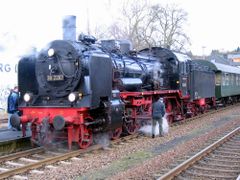
A Prussian P 8, built in 1918
· 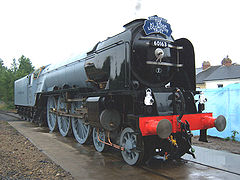
A1 60163 Tornado (LNER class A1, replica 2008)
· 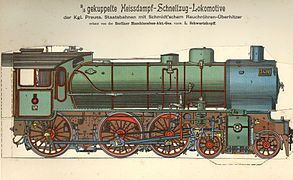
Hot steam express locomotive of the Royal Prussian State Railways, exterior view
· 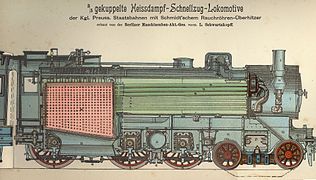
Hot steam express locomotive of the Royal Prussian State Railways, sectional view
The steam locomotive (in short steam locomotive, as a metaphor also steam horse) is a type of locomotive that is driven by steam. In addition to the widespread standard design with steam generator and piston steam engine with crank drive running gear, there are special designs such as fireless locomotives, gear steam locomotives, those with single-axle or turbine drive, condensing and high-pressure locomotives.
Steam locomotives were the first self-propelled, mechanically driven rail vehicles and dominated rail transport from its inception until the middle of the 20th century. Steam locomotives were also the driving force behind the rapid development of transport technology and national and international trade. With the advent of more modern drive technologies, steam locomotives were gradually replaced by diesel and electric traction units due to their comparatively poor efficiency and high operating, maintenance and repair costs. Since the last quarter of the 20th century, the construction of new steam locomotives has been an exception.

Freight steam locomotive 52 7596 of the EFZ in Rottweil
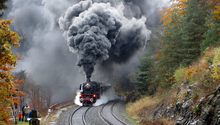
41 018 of the Deutsche Reichsbahn on the inclined plane, 2016

Play media file 41 018 on the inclined plane with 01 1066 as sliding locomotive (Video, 49,2 MiB)
Operation
→ Main article: Railway depot (steam locomotives)
A number of buildings and measures are required for the operation of steam locomotives, which at the time and on the railways that used and operated steam locomotives shaped and characterised their appearance. These included locomotive sheds, especially round sheds, water towers and coaling plants, but also the large-scale clearing of the tracks to prevent forest and field fires caused by flying sparks.
Present
New building steam locomotives
New locomotives from scratch
Although the chapter of steam locomotives seemed to be closed already in the 1970s, the Swiss machine factory SLM (Dampflokomotivfabrik today DLM) delivered three prototypes of new light oil-fired steam locomotives for rack-and-pinion narrow gauge railways in 1992. The vehicles are used where steam locomotives promise significantly higher revenues thanks to their greater attractiveness to tourists at operating costs comparable to those of diesel locomotives. In 1996, five more were sold, three to the Austrian Schafbergbahn and two to the BRB.
The Transports Montreux-Vevey-Riviera sold its locomotive, bought in 1992, to the Brienz-Rothorn Railway in the summer of 2004, instead of letting it run only occasionally under the contact wire on the Rochers de Naye.
On the two mountain railways to the Schafberg and the Brienzer-Rothorn, four DLM machines each now carry the main load of traffic. The diesel railcars and diesel locomotives are only available as reserves. The old coal-fired locomotives, some of which are over 100 years old, are still used for special trips, but are much more expensive to operate and prepare than the new traction units.
Reproductions of old locomotives
Twenty years after the end of new steam locomotive construction in Germany - in 1988, a last series of steam storage locomotives for industrial companies in the GDR was built in Meiningen - two new locomotives were built again in 2009 at the Meiningen steam locomotive plant. They are replicas of German narrow gauge locomotive types: On the one hand, a fourth locomotive of the DR class 99.32 was built for the Bäderbahn Molli, and on the other hand, the Verein zur Förderung Sächsischer Schmalspurbahnen received a replica of a Saxon I K. Both locomotives were completed in the summer of 2009.
In Darlington, England, the A1 Steam Locomotive Trust has rebuilt a 2'C1' h3 LNER class A1 Peppercorn steam locomotive from scratch. This locomotive was built using the old plans from the 1940s, but with today's materials and methods. It entered service in 2008. Following the success of the rebuild, in 2014 the Trust began rebuilding an LNER Class P2 locomotive, the most powerful class of British express locomotive ever built. Other railway companies, such as the Ffestiniog Railway, have also replicated historic locomotives or are planning such projects.
Planned and special transports in German-speaking countries
The following railway companies still operate steam locomotives on a regular basis in German-speaking countries:
- Achenseebahn (Tyrol)
- Brohltalbahn (Rhineland-Palatinate)
- Chiemsee Railway (Bavaria)
- Steam Railway Franconian Switzerland (Bavaria)
- Railway friends Wetterau (Hesse)
- Fichtelbergbahn (Saxony)
- Brienz-Rothorn Railway (Switzerland)
- Steam railway Furka mountain line (Switzerland)
- Lößnitzgrundbahn (Saxony)
- Harz narrow gauge railways (Saxony-Anhalt, Thuringia)
- Bäderbahn Molli (Mecklenburg-Western Pomerania)
- Rügen narrow-gauge railway (Mecklenburg-Western Pomerania)
- Zittau narrow gauge railway (Saxony)
- Schafbergbahn (Upper Austria)
- Schneebergbahn (Lower Austria)
- Weißeritztalbahn (Saxony)
- Zillertalbahn (Tyrol)
- Pinzgauer Lokalbahn (Salzburg)
- Murtalbahn (Styria)
- Bregenzerwaldbahn (Vorarlberg)
- RuhrtalBahn (North Rhine-Westphalia)
- Mansfelder Bergwerksbahn (Mansfeld-Südharz, Saxony-Anhalt)
- Waldviertler narrow gauge railways (Lower Austria)
- Museum Tramway Mariazell-Erlaufsee (Styria)
Also the Deutsche Bahn, especially the DB Regio AG, Verkehrsbetrieb Thüringen, has been using seasonal scheduled steam trains again since 1998. The steam regional express round trips "Rodelblitz" and "Elstertal" run on several weekends in Thuringia and into the neighboring Czech Republic.
In Germany, 39 standard gauge steam locomotives are preserved in working order. Many other locomotives are not in working order and are in museums, set up as monuments, or are currently being reconditioned for operation.
Formerly the fastest operable steam locomotive in the world, the 18 201 has been owned by Wedler Franz Logistik since 2019. The locomotive was also used sporadically in front of special trains. After it had deadline expiration in May 2018, it is no longer usable. A new reconditioning at the Neustrelitz railroad plant is in progress.
Steam locomotive operation outside the German-speaking area
In Poland, three standard gauge steam locomotives are used by the Wolsztyn depot for tourist purposes, as of 2017.
In Bosnia-Herzegovina, steam locomotives are still used on both narrow and standard gauge. Operators are works railways of various coal mines. Status: 2017
In the People's Republic of China, steam locomotives remained in service until the 21st century. Here, especially the operations of the heavy freight locomotives of the class QJ on the Ji-Tong line over the Jipeng Pass in northern China, which was not completed until 1995, achieved international fame among railway enthusiasts. The reasons for this long-lasting era of steam locomotives in China are the cheap coal supply, the easy maintenance, the sufficient manpower to operate the steam locomotives in a manpower-intensive way as well as the still existing infrastructure. In addition, the existing steam locomotives are mostly only a few years old, and the last steam locomotive was completed in October 1999 (SY 1772). In general, attempts are being made to gradually discontinue steam traction in China, mainly for reasons of prestige (people there are ashamed of steam locomotives, which are considered "backward" in Western countries). The last scheduled passenger train with steam traction on the JiTong Railway ran on December 10, 2005, and at the beginning of 2006, the last freight trains there were also switched from steam locomotives to transport with older state railway diesel locomotives of the DF4 series. Since then, regular steam locomotive trips are only performed in shunting and feeder services in opencast coal mines or coal-processing industrial plants, in rare cases also for passenger traffic, as of 2017.
Currently, regular operation of steam locomotives outside of Europe is known from China, Myanmar and India (rather motivated by tourism, see among others Darjeeling Himalayan Railway); Zimbabwe resumed steam operation for shunting services in 2005. In Indonesia, steam locomotives are still used for sugar cane harvesting on factory railways, as of 2017. In Paraguay, there are occasional steam-powered shunting services, as of 2017; in Argentina, several narrow-gauge railways operate with steam for tourist services, as of 2017.

New light oil-fired H 2/3 of the Brienz-Rothorn Railway



